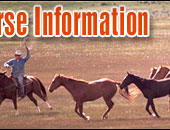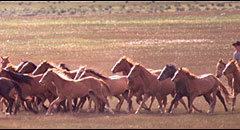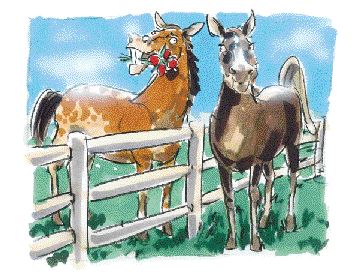 |
   |
|
|
|
You are here: Horses > Horse breeding > Breeding Mares |
Getting Mares Ready for Pregnancy and Horse Breeding in the Winter
Every winter, horse breeders try everything to give Mother
Nature a little extra push in the right direction. Keeping
maiden and barren mares under lights, feeding them a bit
extra, stable managers try to fool these mares into thinking
it was nearing spring and breeding season. |
|
|
Timing is the key at thoroughbred nurseries, because all
thoroughbreds celebrate their birthdays on January first.
Getting mares pregnant as early as possible is one of the
keys to success. Amateur breeders donít have quite the same tight timeline,
but no matter if the mare is a thoroughbred brood mare or a
pleasure horse on the family farm, successful breeding takes
more than letting nature takes its course. Listening to the
pros can give some good advice. |
Even when you do all the tricks to help get your mares Ďin
the mood,í many still will not get pregnant early. Still,
starting the breeding program early does have some
advantages. Mares will need a negative uterine culture
before they go to the breeding farm, and veterinarians will
want to take that culture when she is in season. Keeping an
eye on the mare early allows you to get that taken care of
before going to the breeding farm, so you donít miss out on
any breeding cycles. Not only do missed cycles cost money,
they also reduce the chances of the mare getting pregnant,
especially if she is a maiden.
 On professional breeding farms, barren and maiden mares
begin the new year with daily visits to the teaser. This is
incredibly helpful in determining the mareís breeding status
and determining if she is in season. Even without this help,
you can often determine when your mare is coming into
season. On professional breeding farms, barren and maiden mares
begin the new year with daily visits to the teaser. This is
incredibly helpful in determining the mareís breeding status
and determining if she is in season. Even without this help,
you can often determine when your mare is coming into
season.
Owners who know their mares well will notice when she
becomes a little sulky at the start of her season. Also,
mares will usually show heat to other horses when they are
turned out together. Any time the mare is exposed to another
horse, keep your eyes open and you might detect useful
signs.
Especially with young maidens, mares who are coming in will
usually urinate more frequently, and the urine will be
thicker. Mares will also occasionally show a lower appetite
than usual.
Your veterinarian can also help give your mare a little push
in the right direction. Putting the mare on a ten-day course
of progesterone followed with a shot of prostaglandin can
help bring her into season. However, you should wait until
they have cycled at least once so that the prostaglandin can
work on a corpus luteum (an old ovarian follicle) and get
the maximum benefit of the treatment.
Your veterinarian will play an important role in helping
your mare to get with foal, whether she goes to stay at the
breeding farm, is only shipped in for breeding and then
brought home, and especially if she is artificially
inseminated. Your vet will determine if she is in season,
whether or not ovulation is imminent, and any additional
assistance that might be required after breeding.
The vet can rectally palpate the mare two days after
breeding to see if she has ovulated. If she hasnít, you will
need to return her to the breeding farm. If she has
ovulated, the vet might recommend suturing her. Five days
after breeding, the vet can check her blood progesterone
levels. After eighteen days, tease her if you can to
determine if she is in season. If not, the vet can palpate
her again.
Pregnancy can be checked by ultrasound. If she is carrying
twins, the vet might attempt to abort one fetus at this
early stage to reduce the risk of miscarriage and
complications. The heartbeat should be visible on the
twenty-sixth day after breeding, and the vet will sometimes
ultrasound again to check.
Also, blood tests at eighteen days can determine if the mare
is pregnant. This is especially important for maiden mares
without any pregnancy history to refer to. If the test
indicates a need, the mare can begin taking supplemental
progesterone at this time. However, oral synthetic
progesterone supplements are expensive. One brand, Regumate,
could cost between six and seven hundred dollars over the
course of the mareís pregnancy. If it is needed, vets
generally recommend a one hundred fifty day course. Some
breeders continue the supplementation all the way to term,
but there is no evidence that the additional supplementation
is helpful.
During the first and second trimesters, weight maintenance
is generally the only extra consideration that a pregnant
mare requires. An increase in feed is required in the last
trimester, because the foal gains sixty-five percent of its
overall growth in just this last trimester. Keeping the mare
on her usual exercise regimen does no harm and may do a lot
of good, at least during the first two trimesters. However,
use common sense with any exercise program.
No matter what, making things as clear and easy as possible
for the breeding farm makes sure that you get the most for
your money and helps to eliminate mistakes. Give them all
the information you can, from teasing charts to veterinary
information to shot records. Make sure that your mare is
de-wormed and has had her hooves trimmed if she is going to
stay at the breeding farm for any amount of time. Also, make
sure you send her with a good quality halter and,
preferably, a neck collar with a name tag. And even if you
plan to take her back home right away, make sure to remove
her back shoes.
All these considerations will prevent mistakes and give you
the best chance of being rewarded with a foal three hundred
days from now.

|
Read the next horse breeding article on Caring for an Orphaned Foal. |
|
|
|
|
 |
|
|
 |
 |
  
Visit Equestrian Cupid now.
The best and largest equestrian club for meeting the other half for friendship and marriage
|
|
 |
|
|
|
Horse Education
|
|
|
|
|
Horse Information Topics
|
|
|
|
|
|
|
|
Horse Business Owners
|
| |
Advertise with Us
Have your horse products or services exposed to over 27,000 of our monthly visitors.
|
|
|
|
|
|